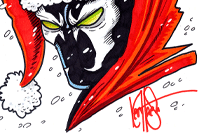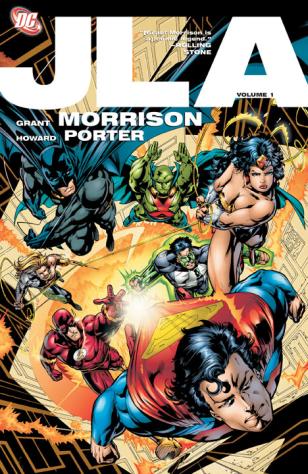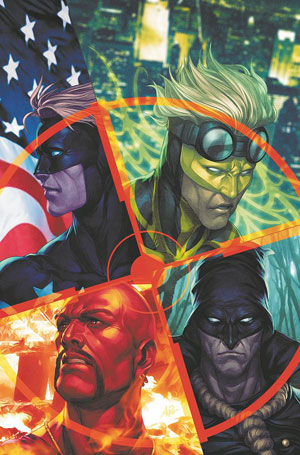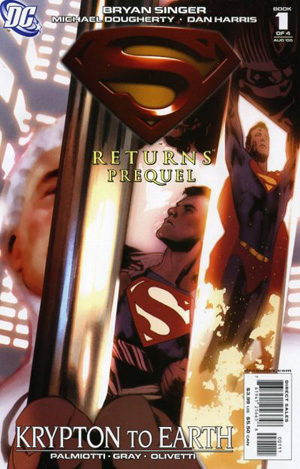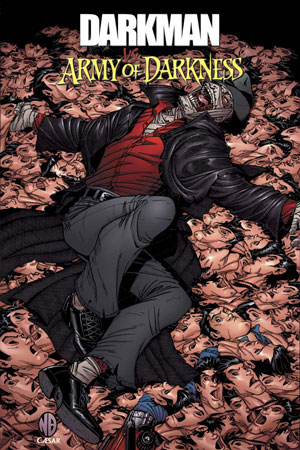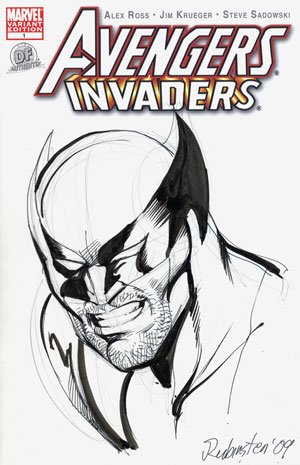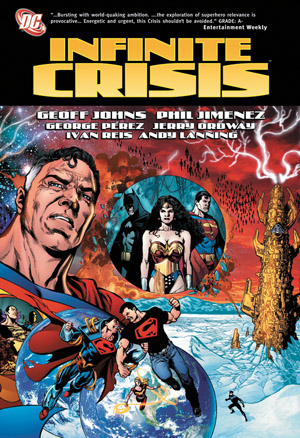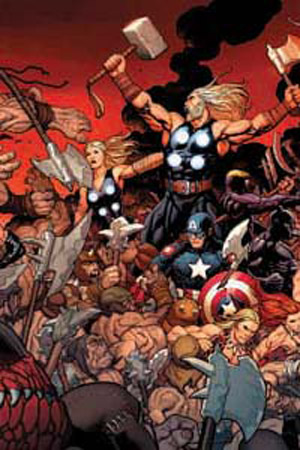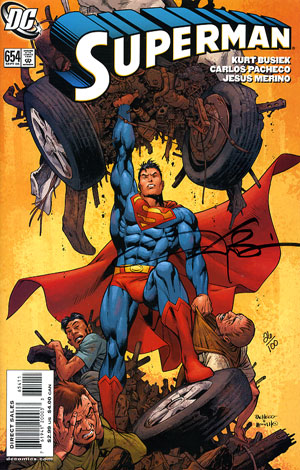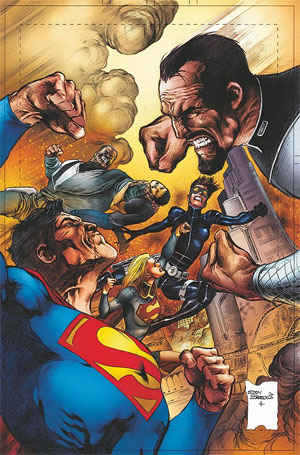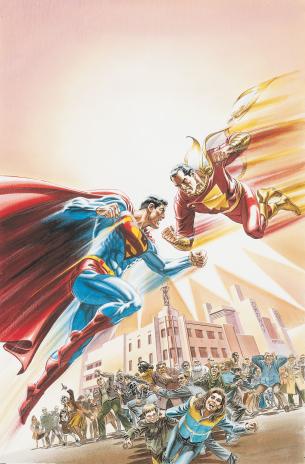|

|
SUPERMAN at the international box office which exceeded expectations. The character has been revamped and updated, most recently in 1986. John Byrne recreated the character, reducing Superman's Powers and erasing several characters from the canon in a move which attracted media attention. Press coverage was again garnered in the 1990s with the Death of Superman, a storyline which saw the character briefly killed.
Superman has also held fascination for scholars, with cultural theorists, commentators and critics alike exploring the character's impact and role in America and the wider world. Umberto Eco discussed the mythic qualities of the character in the early 1960s, and Larry Niven has pondered the implications of a sexual relationship the character might enjoy with Lois Lane. The character's ownership has often been the subject of dispute, with Siegel and Shuster twice suing for the return of legal ownership. The copyright is again currently in dispute, with changes in copyright law allowing Siegel's wife and daughter to claim a share of the copyright, a move DC parent company Warner Bros. disputes.
Creation
Jerry Siegel and Joe Shuster first created a bald telepathic villain bent on dominating the world. He appeared in "The Reign of the Superman", from Science Fiction #3, a science fiction fanzine that Siegel published in 1933. Siegel re-wrote the character in 1933 as a hero, bearing little or no resemblance to his villainous namesake, and began a six-year quest to find a publisher. Titling it The Superman, Siegel and Shuster offered it to Consolidated Book publishing, who had published a 48 page black-and-white comic book entitled Detective Dan: Secret Operative No. 48. Although they received an encouraging letter, Consolidated never published in the comic book market again. Shuster took this to heart, and destroyed all pages of the story, the cover surviving only because Siegel rescued it from the fire. Siegel and Shuster have both reported this version of the character as being comparable to Slam Bradley, a character the pair created in 1937 for the first issue of Detective Comics.
By 1934 the pair had once more re-envisioned the character. He became more of a hero in the mythic tradition, inspired by such characters as Samson and Hercules, who would right the wrongs of Siegel and Shuster's times, fighting for social justice and against tyranny. It was at this stage the costume was introduced, Siegel later recalling that they created a "kind of costume and let's give him a big S on his chest, and a cape, make him as colorful as we can and as distinctive as we can." The design was based in part on the costumes worn by characters in outer space settings published in pulp magazines, as well as comic strips such as Flash Gordon, and also partly suggested by the traditional circus strong-man outfit. However, the cape has been noted as being markedly different from the Victorian tradition, Gary Engle describing it as without "precedent in popular culture" in Superman at Fifty: The Persistence of a Legend. The pants-over-tights outfit was soon established as the basis for many future superhero outfits. This third version of the character was given extraordinary abilities, although this time of a physical nature as opposed to the mental abilities of the villainous Superman.
Although they were by now selling material to comic book publishers, notably Malcolm Wheeler-Nicholson's National Allied Publishing, the pair decided to feature this character in a comic strip format, rather than in the longer comic book story format which was establishing itself at this time. They offered it to both Max Gaines, who passed, and to United Features Syndicate, who expressed interest initially but finally rejected the strip in a letter dated February 18, 1937. However, in what historian Les Daniels describes as "an incredibly convoluted turn of events", Max Gaines ended up positioning the strip as the lead feature in Wheeler-Nicholson's new publication, Action Comics. Vin Sullivan, editor of the new book, wrote to the pair requesting that the comic strips be refashioned to suit the comic book format, requesting "eight panels a page". However Siegel and Shuster ignored this, utilising their own experience and ideas to create page layouts, with Siegel also identifying the Image used for the cover of Action Comics #1, Superman's first appearance, published in June, 1938.
Publication
Superman's first appearance was in Action Comics #1, in 1938. In 1939 a self-titled series was launched. The first issue mainly reprinted adventures published in Action Comics, but despite this the book achieved greater sales. 1939 also saw the publication of New York World's Fair Comics, which by Summer of 1942 became World's Finest Comics. With issue #7 of All Star Comics
Superman made the first of a number of infrequent appearances, on this occasion appearing in cameo to establish his honorary membership of the Justice Society of America.
Initially Jerry Siegel and Joe Shuster would provide the story and art for all the strips published. However Shuster's eyesight began to deteriorate, and the increasing appearances of the character saw an increase in the workload. This led Shuster to establish a studio to assist in the production of the art, although he insisted on drawing the face of every Superman the studio produced. Outside the studio, Jack Burnley began supplying covers and stories in 1940. Wayne Boring, initially employed in Shuster's studio began working for DC in his own right in 1942, providing pages for both Superman and Action Comics.
The scripting duties also became shared. In late 1939 a new editorial team assumed control of the character's adventures. Whitney Ellsworth, Mort Weisinger and Jack Schiff were brought in following Vin Sullivan's departure. This new editorial team brought in Edmond Hamilton, Manly Wade Wellman and Alfred Bester, established writers of science fiction.
By 1943, Jerry Siegel was drafted into the army in a special celebration, and his duties there saw high contributions drop. Don Cameron and Alvin Schwartz joined the writing team, Schwartz teaming up with Wayne Boring to work on the Superman comic strip which had been launched by Siegel and Shuster in 1939.
The Man of Steel #1 (July 1986), written and drawn by John Byrne.In 1945 Superboy made his début in More Fun Comics #101. The character moved to Adventure Comics in 1946, and his own title, Superboy, launched in 1949. The 1950s saw the launching of Superman's Pal Jimmy Olsen (1954) and Superman's Girlfriend Lois Lane (1958). By 1974 these titles had merged into Superman Family, although the series was cancelled in 1982. In 1986 a decision was taken to restructure the fictional universe the Superman character inhabited with other DC Universe characters. This saw the publication of "Whatever Happened to the Man of Tomorrow", a two part story written by Alan Moore, with art by Curt Swan, George Perez and Kurt Schaffenberger. The story was published in Superman #423 and Action Comics #583, and presented what Les Daniels notes as "the sense of loss the fans might have experienced if this had really been the last Superman tale."
Superman was relaunched by writer artist John Byrne, initially in the limited series The Man of Steel (1986). 1986 also saw the cancellation of World's Finest Comics, the Superman title renamed The Adventures of Superman. A second volume of Superman was launched in 1987, running until cancellation in 2006. This cancellation saw The Adventures of Superman revert back to the Superman title. Superman: The Man of Steel was launched in 1991, running until 2003, whilst the quarterly book Superman: The Man of Tomorrow ran from 1995 to 1999. In 2003 Superman/Batman launched, followed by All Star Superman in 2005 and Superman Confidential in 2006.
Influences
An influence on early Superman stories is the context of the Great Depression. The left-leaning perspective of creators Shuster and Siegel is reflected in early storylines. Superman took on the role of social activist, fighting crooked businessmen and politicians and demolishing run-down tenements. This is seen by comics scholar Roger Sabin as a reflection of "the liberal idealism of Franklin Roosevelt's New Deal", with Shuster and Siegal initially portraying Superman as champion to a variety of social causes. In later Superman radio programs the character continued to take on such issues, tackling a version of the KKK in a 1946 broadcast.
Siegel himself noted that the many mythic heroes which exist in the traditions of many cultures bore an influence on the character, including Hercules and Samson. The character has also been seen by Scott Bukatman to be "a worthy successor to Lindhberg ... (and) also ... like Babe Ruth", and is also representative of the United States dedication to "progress and the 'new'" through his "invulnerable body ... on which history cannot be inscribed." Further, given that Siegel and Schuster were noted fans of pulp science fiction, it has been suggested that another influence may have been Hugo Danner. Danner was the main character of the novel Gladiator by Philip Wylie, and is possessed of same Powers of the early Superman (along with many other pulp characters of the twenties and thirties).
Because Siegel and Shuster were both Jewish, it is thought that their creation was partly influenced by Moses, and other Jewish influences. Superman's Kryptonian name, "Kal-El," resembles the Hebrew words קל-אל, which means "vessel of God". The suffix "el", meaning "of God" is also found in the name of angels (e.g. Gabriel, Ariel); flying humanoid agents of good with super-human Powers. Jewish legends of the Golem have been cited as worthy of comparison, a Golem being a mythical being created to protect and serve the persecuted Jews of 16th century Prague and later revived in popular culture in reference to their suffering at the hands of the Nazis in Europe during the 1930s and 1940s. Superman is often seen as being an analogy for Jesus, being a saviour of humanity.
Whilst the term Superman was initially coined by Nietzsche, it is unclear exactly how influential Nietzsche and his ideals were to Siegel and Schuster. Les Daniels has speculated that "Siegel picked up the term from other science fiction writers who had casually employed it", further noting that "his concept is remembered hundreds of millions who may barely know who Nietzsche is." However, it has also been argued that Siegel and Schuster "could not have been unaware of an idea that would dominate Hitler's National Socialism. The concept was certainly well discussed." It has also been argued that in many ways Superman and the Übermensch are polar opposites. Nietzsche envisioned the Übermensch as a man who had transcended the limitations of society, religion, and conventional morality while still being fundamentally human. Superman, although an alien gifted with incredible Powers, chooses to honor human moral codes and social mores. Nietzsche envisioned the perfect man as being beyond moral codes; Siegel and Shuster envisioned the perfect man as holding himself to a higher standard of adherence to them.
Siegel and Shuster have themselves discussed a number of influences which impacted upon the character. Both were avid readers, and this love of reading, particularly science fiction helped to drive their friendship. Siegel has noted the John Carter stories as an influence: "Carter was able to leap great distances because the planet Mars was smaller that the planet Earth; and he had great strength. I visualized the planet Krypton as a huge planet, much larger than Earth". The pair were also avid collectors of comic strips in their youth, cutting them from the newspaper, with Winsor McKay's Little Nemo firing their imagination with its sense of fantasy. Shuster has remarked on the artists which played an important part in the development of his own style, whilst also noting a larger influence: "Alex Raymond and Burne Hogarth were my idols-also Milt Caniff, Hal Foster, and Roy Crane. But the movies were the greatest influence on our imagination: especially the films of Douglas Fairbanks Senior." Fairbanks' role as Robin Hood was certainly an inspiration, as Shuster admitted to basing Superman's stance upon scenes from the movie. The movies also influenced the storytelling and page layouts, whilst the city of Metropolis was named in honor of the Fritz Lang movie of the same title.
Copyright issues
As part of the deal which saw Superman published in Action Comics, Siegel and Shuster sold the rights to the company in return for $130 and a contract to supply the publisher with material. The Saturday Evening Post reported in 1940 that the pair was each being paid $75,000 a year, a fraction of Detective's millions in Superman profits. Siegel and Shuster renegotiated their deal, but bad blood lingered and in 1947 Siegel and Shuster sued for their 1938 contract to be made void and the re-establishment of their ownership of the intellectual property rights to Superman. The pair also sued Detective in the same year over the rights to Superboy, which they claimed was a separate creation that Detective had published without authorization. Detective immediately fired them and took their byline off the stories, prompting a legal battle that ended in 1948, when a New York Supreme Court ruled that the 1938 contract should be upheld. However, a ruling from Justice J. Addison Young awarded them the rights to Superboy. A month after the Superboy judgement the two sides agreed on a settlement. Detective paid Siegel and Shuster $94,000 for the rights to Superboy. The pair also acknowledged in writing the company's ownership of Superman, attesting that they held rights for "all other forms of reproduction and presentation, whether now in existence or that may hereafter be created", but DC refused to re-hire them.
In 1973 Siegel and Shuster again launched a suit claiming ownership of Superman, this time basing the claim on the Copyright Act of 1909 which saw copyright granted for 28 years but allowed for a renewal of an extra 28 years. Their argument was that they had granted DC the copyright for only 28 years. The pair again lost this battle, both in a district court ruling of October 18, 1973 and an appeal court ruling of December 5, 1974.
In 1975 after news reports of their pauper-like existences, Warner Communications gave Siegel and Shuster lifetime pensions of $20,000 per year and health care benefits. Jay Emmett, then executive vice president of Warner, was quoted in the New York Times as stating "There is no legal obligation, but I sure feel there is a moral obligation on our part." In addition, any media production which includes the Superman character were to include the credit "Superman created by Jerry Siegel and Joe Shuster".
Jerry Siegel, with wife Joanne and daughter Laura in 1976. Joanne and Laura Siegel filed a termination notice on Jerry Siegel's share of the copyright of Superman in 1999.The year after this settlement, 1976, saw the copyright term extended again, this time for another 19 years to a total of 75 years. However, this time a clause was inserted into the extension to allow a creator to reclaim their work, reflecting the arguments Siegel and Shuster had made in 1973. The new act came into power in 1978 and allowed a reclamation window in a period based on the previous copyright term of 56 years. This meant the copyright on Superman could be reclaimed between 1994 to 1999, based on the initial publication date of 1938. Jerry Siegel having died in January 1996, his wife and daughter filed a copyright termination notice in 1999. Although Joe Shuster died in July 1992, no termination was filed at this time by his estate.
1998 saw copyright extended again, with the Sonny Bono Copyright Term Extension Act. This time the copyright term was extended to 95 years, with a further window for reclamation introduced. In January of 2004 Mark Peary, nephew and legal heir to Joe Shuster's estate, filed notice of his intent to reclaim Shuster's half of the copyright, the termination effective in 2013. The status of Siegel's share of the copyright is now the subject of a legal battle. Warner Bros. and the Siegels entered into discussions on how to resolve the issues raised by the termination notice, but these discussions were set aside by the Siegels and in October 2004 they filed suit alleging copyright infringement on the part of Warner Bros. Warner Bros. counter sued, alleging the termination notice contains defects amongst other arguments. The copyright ownership of Superman currently appears uncertain, with a decision "the subject of ongoing negotiation" and an outcome "still pending".
A similar termination of copyright notice filed in 2002 by Siegel's wife and daughter concerning the Superboy character was ruled in their favour on March 23, 2006.
Comic book character
Main article: History of Superman
See also: Kal-L
Superman, given the serial nature of comic publishing and the length of the character's existence, has evolved as a character as his adventures have increased. The details of Superman's origin, relationships and abilities changed significantly during the course of the character's publication, from what is considered the Golden Age of comic books through the Modern Age. The Powers and villains were developed through the 1940s, with Superman developing the ability to fly, and costumed villains introduced from 1941. The character was shown as learning of the existence of Krypton in 1949. The concept itself had originally been established to the reader in 1939, in the Superman comic strip.
The 1960s saw the introduction of a second Superman, Kal-L. DC had established a multiverse within the fictional universe its characters shared. This allowed characters published in the 1940s to exist alongside updated counterparts published in the 1960s. This was explained to the reader through the notion that the two groups of characters inhabited parallel Earths. The second Superman was introduced to explain to the reader Superman's membership of both the 1940s superhero team the Justice Society of America and the 1960s superhero team the Justice League of America.
Art from Superman #75 (January 1993), where Superman dies in Lois Lane's arms. Pencils by Dan Jurgens.The 1980s saw radical revisions of the character. DC Comics decided to remove the multiverse in a bid to simplify its comics line. This led to the rewriting of the back story of the characters DC published, Superman included. John Byrne rewrote Superman, removing many established conventions and characters from continuity, including Superboy and Supergirl. Byrne also re-established Superman's adoptive parents, The Kents, as characters. In the previous continuity the characters had been written as having died early in Superman's life (about the time of Clark Kent's graduation from high school). The 1990s saw Superman killed by the villain Doomsday, although the character was soon resurrected. Superman also marries Lois Lane in 1996. In the 2000s Superman becomes a vegetarian, and his origin is again revisited in 2004. In 2006 Superman is stripped of his Powers, although these are restored within a fictional year.
Personality
In the original Siegel and Shuster stories, Superman's personality is rough and aggressive. The character was seen stepping in to stop wife beaters, profiteers, a lynch mob and gangsters, with rather rough edges and a looser moral code than audiences may be used to today. Later writers have softened the character, and instilled a sense of idealism and moral code of conduct. Although not as cold-blooded as the early Batman, the Superman featured in the comics of the 1930s is unconcerned about the harm his strength may cause, tossing villainous characters in such a manner that fatalities would presumably occur, although these were seldom shown explicitly on the page. This came to an end late in 1940, when new editor Whitney Ellsworth instituted a code of conduct for his characters to follow, banning Superman from ever killing.
In Superman/Batman #3, Batman thinks, "It is a remarkable dichotomy. In many ways, Clark is the most human of us all. Then...he shoots fire from the skies, and it is difficult not to think of him as a god. And how fortunate we all are that it does not occur to him."
Powers and abilities
Main article: Powers and abilities of Superman
As an influential archetype of the superhero genre, Superman possesses extraordinary Powers, with the character traditionally described as "faster than a speeding bullet, more powerful than a locomotive, and able to leap tall buildings in a single bound", a phrase coined by Jay Morton and first used in the Superman radio serials and Max Fleischer animated shorts of the 1940s as well as the TV series of the 1950s. For most of his existence, Superman's famous arsenal of Powers include flight, super-strength, invulnerability to non-magical attacks of ordinary force, super-speed, vision Powers (including x-ray, heat, telescopic, infra-red, and microscopic vision), super-hearing, and super-breath, which enables him to freeze objects by blowing on them, as well as exert the propulsive force of high-speed winds.
As originally conceived and presented in his early stories, Superman's Powers were relatively limited, consisting of superhuman strength that allowed him to lift a car over his head, run at amazing speeds and leap one-eighth of a mile, as well as incredibly tough skin that could be pierced by nothing less than an exploding artillery shell. Siegel and Shuster compared his strength and leaping abilities to an ant and a grasshopper. When making the cartoons, the Fleischer Brothers found it difficult to keep animating him leaping and requested to DC to change his ability to flying. Writers gradually increased his Powers to larger extents during the Silver Age, in which Superman could fly to other worlds and galaxies and even across universes with relative ease. He would often fly across the solar system to stop meteors from hitting the Earth, or sometimes just to clear his head. Writers found it increasingly difficult to write Superman stories in which the character was believably challenged, so DC Comics made a series of attempts to rein the character in. The most significant attempt, John Byrne's 1986 rewrite, established several hard limits on his abilities: He barely survives a nuclear blast, and his space flights are limited by how long he can hold his breath. Superman's power levels have again increased since then, with Superman currently possessing enough strength to hurl a mountain, withstand nuclear blasts with ease, and survive in the vacuum of outer space without oxygen.
The source of Superman's Powers has changed subtly over the course of his history. It was originally stated that Superman's abilities derived from his Kryptonian heritage, which made him eons more evolved than humans. This was soon amended, with the source for the Powers now based upon the establishment of Krypton's gravity as having been stronger than that of the Earth. This situation mirrors that of Edgar Rice Burroughs' John Carter. As Superman's Powers increased, the implication that all Kryptonians had possessed the same abilities became problematic for writers, making it doubtful that a race of such beings could have been wiped out by something as trifling as an exploding planet. In part to counter this, the Superman writers established that Kryptonians, whose native star Rao had been red, only possessed superPowers under the light of a yellow sun. More recent stories have attempted to find a balance between the two explanations.
Superman is most vulnerable to Kryptonite, mineral debris from Krypton transformed into radioactive material by the forces that destroyed the planet. Exposure to Kryptonite radiation nullifies Superman's Powers and immobilizes him with pain; prolonged exposure will eventually kill him. The only mineral on Earth that can protect him from Kryptonite is lead, which blocks the radiation. Kryptonite was first introduced to the public in 1943 as a plot device to allow the radio serial voice actor, Bud Collyer, to take some time off. Green Kryptonite is the most commonly seen form but writers introduced other forms over the years, such as red, gold, blue and black, each with its own effect.
Supporting cast
Main article: Superman character and cast
Clark Kent, Superman's secret identity, was based partly on Harold Lloyd and named after Clark Gable and Kent Taylor. Creators have discussed the idea of whether Superman pretends to be Clark Kent or vice versa, and at differing times in the publication either approach has been adopted. Although typically a newspaper reporter, during the 1970s the character left the Daily Planet for a time to work for television, whilst the 1980s revamp by John Byrne saw the character become somewhat more aggressive. This aggressiveness has since faded with subsequent creators restoring the mild mannerisms traditional to the character.
Superman's large cast of supporting characters includes Lois Lane, perhaps the character most commonly associated with Superman, being portrayed at different times as his colleague, competitor, love interest and/or wife. Other main supporting characters include Daily Planet coworkers such as photographer Jimmy Olsen and editor Perry White, Clark Kent's adopted parents Jonathan and Martha Kent, childhood sweetheart Lana Lang and best friend Pete Ross, and former college love interest Lori Lemaris (a mermaid). Stories making reference to the possibility of Superman siring children have been featured both in and out of mainstream continuity.
Incarnations of Supergirl, Krypto the Superdog, and Superboy have also been major characters in the mythos, as well as the Justice League of America (of which Superman is usually a member). A feature shared by several supporting characters is alliterative names, especially with the initials "LL", including Lex Luthor, Lois Lane, Linda Lee, Lana Lang, Lori Lemaris and Lucy Lane, alliteration being common in early comics.
Team-ups with fellow comics ICON Batman are common, inspiring many stories over the years. When paired, they are often referred to as the "World's Finest" in a nod to the name of the comic book series that features many team-up stories. In 2003, DC Comics began to publish a new series featuring the two characters titled Superman/Batman.
Superman also has a rogues gallery of enemies, including his most well-known nemesis, Lex Luthor, who has been envisioned over the years in various forms as either a rogue scientific genius with a personal vendetta against Superman, or a powerful but corrupt CEO of a conglomerate called LexCorp. In the 2000s, he even becomes President of the United States, and has been depicted at various stages, as well as currently, as a former childhood friend of Clark Kent.
The alien android (in most incarnations) known as Brainiac is considered by Richard George to be the second most effective enemy of Superman. The enemy that accomplished the most, by actually killing Superman, is the raging monster Doomsday. Darkseid, one of the most powerful beings in the DC Universe, is also a formidable nemesis in most post-crisis comics. Other enemies who have featured in various incarnations of the character, from comic books to film and television include the fifth-dimensional imp Mr. Mxyzptlk, the reverse Superman known as Bizarro and the Kryptonian criminal General Zod.
Cultural impact
Superman has come to be seen as both an American cultural ICON and the first comic book superhero. His adventures and popularity have established the character as an inspiring force within the public eye, with the character serving as inspiration for musicians, comedians and writers alike.
Inspiring a market
The character's initial success led to similar characters being created. Batman was the first to follow, Bob Kane commenting to Vin Sullivan that given the "kind of money (Siegel and Shuster were earning) you'll have one on Monday". Victor Fox, an accountant for DC, also noticed the revenue such comics generated, and commissioned Will Eisner to create a deliberately similar character to Superman. Wonder Man was published in May 1939, and although DC successfully sued, claiming plagiarism, Fox had decided to cease publishing the character. Fox later had more success with the Blue Beetle. Fawcett Comics' Captain Marvel, launched in 1940, was Superman's main rival for popularity throughout the 1940s, and was again the subject of a lawsuit, which Fawcett eventually settled in 1953, a settlement which involved the cessation of the publication of the character's adventures. Superhero comics are now established as the dominant genre in American comic book publishing, with many thousands of characters in the tradition having been created in the years since Superman's creation.
Merchandising
Superman became popular very quickly, with an additional title, Superman Quarterly quickly added. In 1940 the character was represented in the annual Macy's parade for the first time. In fact Superman had become popular to the extent that in 1942, with sales of the character's three titles standing at a combined total of over 1.5 million, Time was reporting that "the Navy Department (had) ruled that Superman comic books should be included among Essential supplies destined for the Marine garrison at Midway Islands." The character was soon licensed by companies keen to cash in on this success through merchandising. The earliest paraphernalia appeared in 1939, a button proclaiming membership in the Supermen of America club. By 1940 the amount of merchandise available increased dramatically, with jigsaw puzzles, paper dolls, bubble gum and trading cards available, as well as wooden or metal figures. The popularity of such merchandise increased when Superman was licensed to appear in other media, and Les Daniels has written that this represents "the start of the process that media moguls of later decades would describe as 'synergy.'" By the release of Superman Returns, Warner Bros. had arranged a cross promotion with Burger King, and licensed many other products for sale. Superman's appeal to licensees rests upon the character's continuing popularity, cross market appeal and the status of the S-Shield, the magenta and gold S emblem Superman wears on his chest, as a fashion symbol.
Adaptations in other media
Main article: Superman in popular culture
Christopher Reeve as Superman in Superman IIThe character of Superman has appeared in various media aside from comic books. This is in some part seen to be owing to the character's cited standing as an American cultural ICON, with the concept's continued popularity also being taken into consideration, but is also seen in part as due to good marketing initially. The character has been developed as a vehicle for serials on radio, television and film, as well as feature length motion pictures, and computer and video games have also been developed featuring the character on multiple occasions.
The first adaptation of Superman was as a daily newspaper comic strip, launching on January 16, 1939. The strip ran until May 1966, and significantly, Siegel and Shuster used the first strips to establish Superman's backstory, adding details such as the planet Krypton and Superman's father, Jor-El, concepts not yet established in the comic books. Following on from the success of this was the first radio series, The Adventures of Superman, which premiered on February 12, 1940 and featured the voice of Bud Collyer as Superman. The series ran until March, 1951. Collyer was also cast as the voice of Superman in the Fleischer Studios animated cartoons, distributed via movie theatres. Seventeen shorts were produced between 1941 and 1943. By 1948 Superman was back in the movie theatres, this time in a filmed serial, Superman, with Kirk Alyn becoming the first actor to portray Superman on screen. A second serial, Atom Man vs. Superman, followed in 1950.
In 1951 a television series was commissioned, starring George Reeves, with the pilot episode of the series gaining a theatrical release as Superman and the Mole Men. The series ran for a 104 episodes, from 1952 - 1958. The next adaptation of Superman occurred in 1966, when Superman was adapted for the stage in the Broadway musical It's a Bird...It's a Plane...It's Superman. The play wasn't successful, closing after 128 performances, although a cast recording was released as an album. However, in 1975 the play was remade for television. Superman was again animated, this time for television, in the series "The New Adventures of Superman". 68 shorts were made and broadcast between 1966 and 1969. Bud Collyer again provided the voice for Superman. Then from 1973 until 1984 ABC broadcast the "Super Friends" series, this time animated by Hanna-Barbera.
Superman returned to movie theatres in 1978, with director Richard Donner's Superman starring Christopher Reeve. The film spawned three sequels, Superman II (1980), Superman III (1983) and Superman IV: The Quest For Peace (1987). In 1988 Superman returned to television in the Ruby Spears animated series Superman, and also in Superboy, a live action series which ran from 1988 until 1992. In 1993 Lois & Clark: The New Adventures of Superman premiered on television, starring Dean Cain as Superman and Teri Hatcher as Lois Lane. The series ran until 1997. Superman: The Animated Series was produced by Warner Bros. and ran from 1996 until 2000 on The WB Television Network. In 2001 the Smallville television series launched, focussing on the adventures of Clark Kent as a teenager before he dons the mantle of Superman. In 2006 Bryan Singer directed Superman Returns, starring Brandon Routh as Superman.
Musical references, parodies and homages
See also: Superman in popular music
Superman has also featured as an inspiration for musicians, with songs by numerous artists from several generations celebrating the character. Donovan's Billboard Hot 100 topping single "Sunshine Superman" utilised the character in both the title and the lyric, declaring "Superman and Green Lantern got nothing on me". Other tracks to reference the character include Genesis' "Land of Confusion", the video to which featured a Spitting Image puppet of Ronald Reagan dressed as Superman, and "Superman" by The Clique, a track later covered by R.E.M. on their 1986 album Lifes Rich Pageant. This cover is referenced by Grant Morrison in Animal Man, in which Superman meets the character, and the track comes on Animal Man's walkman immediately after.
Parodies of Superman did not take long to appear, with Mighty Mouse introduced in "The Mouse of Tomorrow" animated short in 1942. Whilst the character swiftly took on a life of its own, moving beyond parody, other animated characters soon took their turn to parody the character. In 1943 Bugs Bunny was featured in a short, Super-Rabbit, which sees the character gaining Powers through eating fortified carrots. This short ends with Bugs stepping into a phone booth to change into a real "Superman", and emerging as a U.S. Marine. In 1956 Daffy Duck assumes the mantle of "Cluck Kent" in the short "Stupor Duck", a role later reprised in various issues of the Looney Tunes comic book. In the United Kingdom Monty Python created the character Bicycle Repairman, who fixes bicycles on a world full of Supermen, for a sketch in series of their BBC show. Also on the BBC was the sit-com "My Hero", which presented Thermoman as a slightly dense Superman pastiche, attempting to save the world and pursue romantic aspirations. In America, Saturday Night Live has often parodied the figure, with Margot Kidder reprising her role as Lois Lane in a 1979 episode. Jerry Seinfeld, a noted Superman fan, filled his series Seinfeld with references to the character, and in 1997 asked for Superman to co-star with him in a commercial for American Express. The commercial aired during the 1998 play offs and Super Bowl, Superman animated in the style of artist Curt Swan, again at the request of Seinfeld.
Superman has also been used as reference point for writers, with Steven T. Seagle's graphic novel Superman: It's a Bird exploring Seagle's feelings on his own mortality as he struggles to develop a story for a Superman tale. Brad Fraser used the character as a reference point for his play Poor Super Man, with The Independent noting the central character, a gay man who has lost many friends to AIDS as someone who "identifies all the more keenly with Superman's alien-amid-deceptive-lookalikes status."
Literary analysis
Superman has been interpreted and discussed in many forms in the years since his debut. The character's status as the first costumed superhero has allowed him to be used in many studies discussing the genre, Umberto Eco noting that "he can be seen as the representative of all his similars". Writing in Time Magazine in 1971, Gerald Clarke stated: "Superman's enormous popularity might be looked upon as signalling the beginning of the end for the Horatio Alger myth of the self-made man." Clarke viewed the comics characters as having to continuously update in order to maintain relevance, and thus representing the mood of the nation. He regarded Superman's character in the early seventies as a comment on the modern world, which he saw as a place in which "only the man with superPowers can survive and prosper." Andrew Arnold, writing in the early 21st century, has noted Superman's partial role in exploring assimilation, the character's alien status allowing the reader to explore attempts to fit in on a somewhat superficial level.
A.C. Grayling, writing in The Spectator, traces Superman's stances through the decades, from his 1930s campaign against crime being relevant to a nation under the influence of Al Capone, through the 1940s and World War II, a period in which Superman helped sell war bonds, and into the 1950s, where Superman explored the new technological threats. Grayling notes the period after the Cold War as being one where "matters become merely personal: the task of pitting his brawn against the brains of Lex Luthor and Brainiac appeared to be independent of bigger questions", and discusses events post 9/11, stating that as a nation "caught between the terrifying George W. Bush and the terrorist Osama bin Laden, America is in earnest need of a Saviour for everything from the minor inconveniences to the major horrors of world catastrophe. And here he is, the down-home clean-cut boy in the blue tights and red cape".
Clark Kent, argued by Jules Feiffer to be the most innovative feature of SupermanScott Bukatman has discussed Superman, and the superhero in general, noting the ways in which they humanize large urban areas through their use of the space, especially in Superman's ability to soar over the large skyscrapers of Metropolis. He writes that the character "represented, in 1938, a kind of Corbusierian ideal. Superman has X-ray vision: walls become permeable, transparent. Through his benign, controlled authority, Superman renders the city open, modernist and democratic; he furthers a sense that Le Corbusier described in 1925, namely, that 'Everything is known to us'."
Jules Feiffer has argued that Superman's real innovation lay in the creation of the Clark Kent persona, noting that what "made Superman extraordinary was his point of origin: Clark Kent." Feiffer develops the theme to establish Superman's popularity in simple wish fulfilment, a point Siegel and Shuster themselves supported, Siegel commenting that "If you're interested in what made Superman what it is, here's one of the keys to what made it universally acceptable. Joe and I had certain inhibitions... which led to wish-fulfillment which we expressed through our interest in science fiction and our comic strip. That's where the dual-identity concept came from" and Shuster supporting that as being "why so many people could relate to it".
Popularity
Superman, both the character and his various comic series, have received various awards over the years. The Reign of the Supermen is one of many storylines or works to have received a Comics Buyer's Guide Fan Award, winning the Favorite Comic Book Story category in 1993. Superman came at number 2 in VH1's Top Pop Culture ICONs 2004. In the same year British cinemagoers voted Superman as the greatest superhero of all time. Works featuring the character have also garnered six Eisner Awards and three Harvey Awards, either for the works themselves or the creators of the works. The Superman films have, as of 2007, received a number of nominations and awards, with Christopher Reeve winning a BAFTA for his performance in Superman. The Smallville television series has garnered Emmys for crew members and various other awards. Superman as a character is still seen as being as relevant now as he has been in the more than sixty years of his existence
This article uses material from Wikipedia and is licensed under the GNU Free Documentation License.All material is compiled from numerous sources and may not be accurate. Dynamic Forces, Inc and all of its subsidiaries cannot guarantee the validity of the content. |
 |

